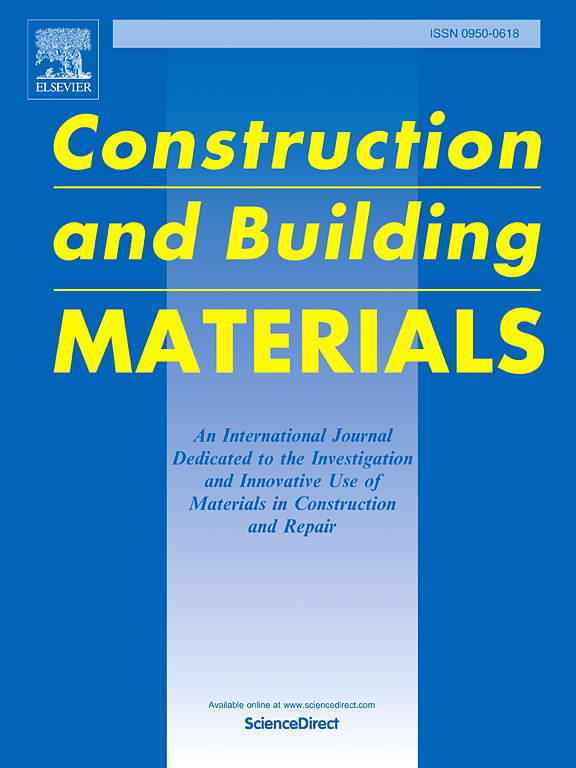Experimental study and theoretical analysis on mechanical properties of prestressed bolted glulam connections under cyclic loading
IF 8
1区 工程技术
Q1 CONSTRUCTION & BUILDING TECHNOLOGY
引用次数: 0
Abstract
Due to the development of assembled buildings and public environmental awareness, glulam structures have been widely concerned nowadays which have the advantages in terms of energy efficiency and environmental protection, compared with concrete and steel. However, the beam-to-column connections connected by bolts with slotted-in plates in glulam frame structures generally have some disadvantages, such as the low load-bearing capacity, low stiffness, low ductility, and poor energy dissipation capacity. To improve the mechanical performances of conventional glulam beam-to-column connections against seismic effect, a prestressed bolted glulam connection was proposed in this paper. Twelve connection specimens from four groups were tested and numerically studied under cyclic loading. The results show that the application of prestressing force can improve the brittle failure of connections. Compared with the traditional glulam bolted connections, the application of prestressing force can improve the load-bearing capacity, energy dissipation capacity, ductility and initial stiffness of the connection, and slow down the stiffness and strength degradation. However, excessive prestressing may cause an early failure of the connection. The numerical analysis shows that the bolt diameter and the number of steel bars have significant positive influence on the load-bearing capacity of the connection. Even though increasing bolt diameter would be more efficient for the mechanical behavior of the connection, the transverse splitting failure of glulam would be more likely to occur. A calculation formula for the load-bearing capacity and a theoretical model for the moment-rotation relationship of the prestressed bolted glulam beam-column connections are proposed respectively for practical design. The rotation behavior evaluation of the prestressed bolted glulam beam-column connections indicates that the proposed connections are classified as semi-rigid connections, which can be used for ductility design.
循环荷载作用下预应力胶合木螺栓连接力学性能的试验研究与理论分析
由于装配式建筑的发展和公众环保意识的增强,胶合层结构由于其相对于混凝土和钢材具有节能环保的优势而受到广泛关注。然而,在胶合木框架结构中,采用螺栓与槽板连接的梁柱连接普遍存在承载力低、刚度低、延性低、耗能能力差等缺点。为了提高常规胶合木梁柱连接的抗震性能,提出了一种预应力栓接胶合木连接。对4组12个连接试件进行了循环加载试验和数值研究。结果表明,施加预应力可以改善连接节点的脆性破坏。与传统胶合木螺栓连接相比,施加预应力可以提高连接的承载能力、耗能能力、延性和初始刚度,减缓连接的刚度和强度退化。然而,过多的预应力可能会导致连接的早期破坏。数值分析表明,螺栓直径和钢筋数量对连接的承载能力有显著的正影响。尽管增大螺栓直径对连接的力学性能更有效,但也更容易发生胶合层的横向劈裂破坏。提出了预应力胶合木梁-柱连接的承载力计算公式和弯矩-转动关系的理论模型,供实际设计时参考。通过对预应力栓接胶合木梁柱连接的旋转性能评价,表明该连接属于半刚性连接,可用于延性设计。
本文章由计算机程序翻译,如有差异,请以英文原文为准。
求助全文
约1分钟内获得全文
求助全文
来源期刊

Construction and Building Materials
工程技术-材料科学:综合
CiteScore
13.80
自引率
21.60%
发文量
3632
审稿时长
82 days
期刊介绍:
Construction and Building Materials offers an international platform for sharing innovative and original research and development in the realm of construction and building materials, along with their practical applications in new projects and repair practices. The journal publishes a diverse array of pioneering research and application papers, detailing laboratory investigations and, to a limited extent, numerical analyses or reports on full-scale projects. Multi-part papers are discouraged.
Additionally, Construction and Building Materials features comprehensive case studies and insightful review articles that contribute to new insights in the field. Our focus is on papers related to construction materials, excluding those on structural engineering, geotechnics, and unbound highway layers. Covered materials and technologies encompass cement, concrete reinforcement, bricks and mortars, additives, corrosion technology, ceramics, timber, steel, polymers, glass fibers, recycled materials, bamboo, rammed earth, non-conventional building materials, bituminous materials, and applications in railway materials.
 求助内容:
求助内容: 应助结果提醒方式:
应助结果提醒方式:


